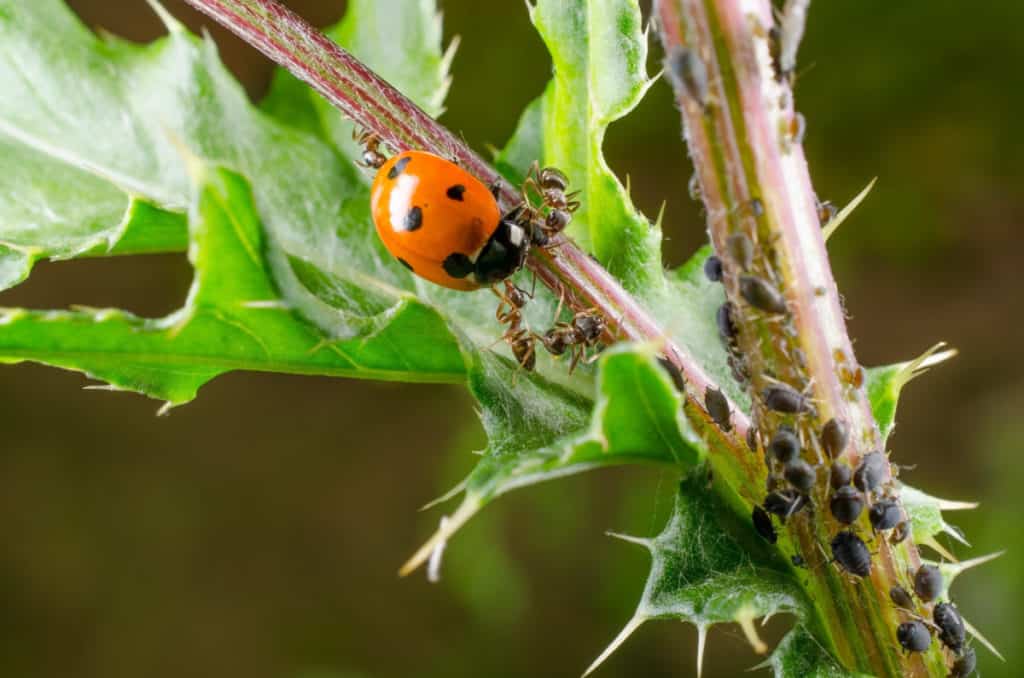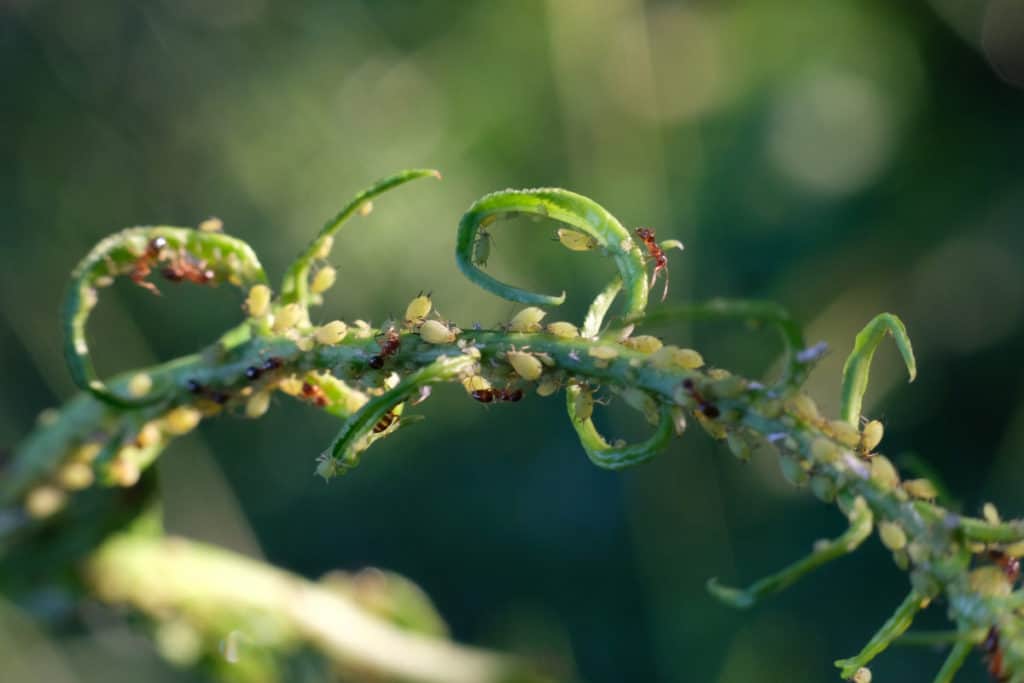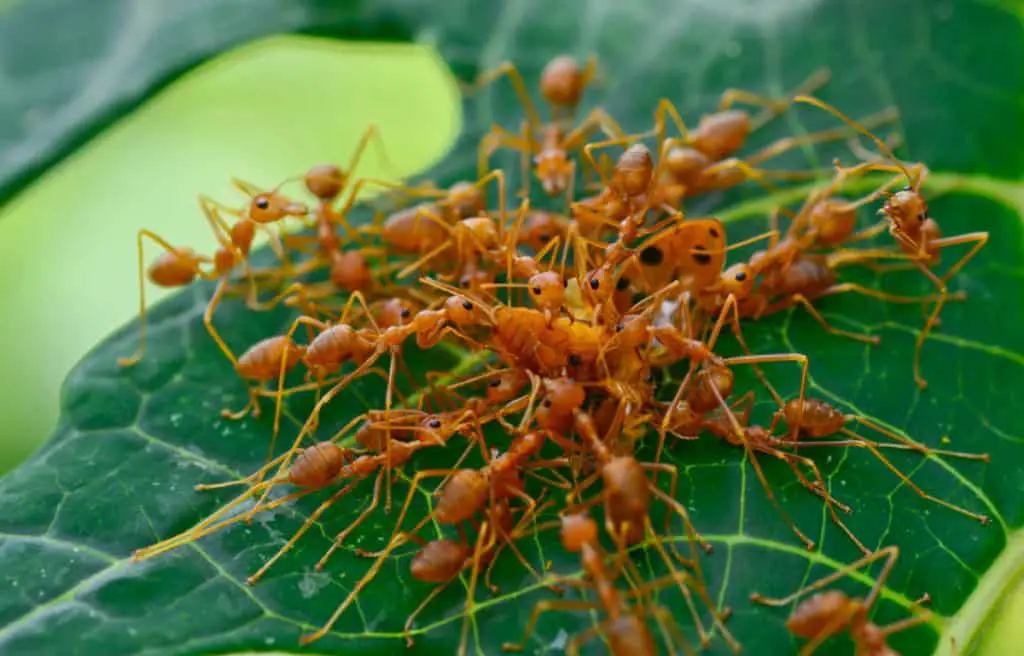They are pretty, graceful, and most of them are harmless to human beings. Not only are they beautiful, but they are also beneficial to farmers. These majestic creatures help eradicate aphids, spider mites, mealybugs, and other plant-eating pests. Shockingly, one ladybug can eat 5000 aphids in a lifetime.
Do ladybugs eat ants?
No, ladybugs don’t prey on or attack ants. However, they clash over a common interest; aphids. Ladybugs eat aphids while ants feed on honeydew, the aphid’s waste matter. They camp near existing aphid colonies close to their food source. Ants are actually more likely to eat ladybugs if they can.
There is more than meets the eye concerning these three fantastic insects; ants, aphids, and ladybugs. Stick around as we uncover the beneficial association between ants and aphids, how ants protect their cows, what happens when a predator like a ladybug shows up, and much more.
Where Do Ants and Ladybugs Meet?
Ants and ladybugs meet around their food sources. Ants maintain a mutually beneficial relationship with aphids, mealybugs, and other sack-sapping insects. Aphids suck the sap out of plants and excrete honeydew.
This nectar-rich product provides food for the ants. On the other hand, aphids are ladybugs’ favorite meal. They hunt them voraciously and lay eggs close to aphid colonies to get a continuous food supply for themselves and their young ones. In their daily life, they can consume up to 50 aphids in a day.

What Happens When a Ladybug and an Ant meet? Who Wins in the Showdown?
Usually, when a ladybug and an ant meet, no one is interested in the other. They are not enemies either. The ant is after protecting aphids and mealybugs, while the ladybug is after eating them. They have existed from evolution alongside each other and have been able to survive together. Winning here depends on the numbers involved and the dynamics employed. A ladybug may endure a one or two ant attack but will move on when backup ants show up.
How Ants and Ladybugs Protect Themselves from Each Other
If a ladybug is overwhelmed by numbers, she will tuck her legs in, lay low and rely on her hard shell to defend her. In such an instance, the ants will try to kill the ladybug and take her to their nest as food.
If they maneuver to get under the ladybug’s shell, they use their strong pincer jaws to bite the victim as well as spray formic acid in its underbelly. In this case, the ladybug may urgently need an escape route or succumb to the ant’s attack.
Ladybugs do have their own defence mechanism, a foul-smelling fluid they release from their legs that is to deter predators. When it comes to ants flying away can be the best option for the ladybug.
When overwhelmed, a ladybug may be unable to fly away, which is the best defense in such a situation. To fly, a ladybug requires lifting their elytra, which exposes their soft wings and body. This makes it prone to further attack. Some ants’ species are more aggressive than others, while others are larger and use different attack mechanisms
When a ladybug accidentally lands in an ant nest, the ants will take it as a threat. They are well organized, and they will rapidly respond by repelling or killing the intruder to defend themselves. It is up to the ladybug to sense the danger ahead and escape to avoid being overwhelmed.
How Ants Protect Their Livestock
Farming ants and aphids share a symbiotic relationship which means they both benefit from the association. Aphids produce milk for the ants, and in exchange, the ants protect the aphids from predators and parasites. They spread out on a farm as soldiers to ensure their “cows” are well fed and safe. They use their strong pincer mandibles and secret formic acid as their weapons of defense.

Some farming ant species even go an extra mile by building shelter for aphids or even relocating them to another plant, when sap dries up. They also collect and store aphid eggs in their nests during winter and at the onset of spring, they carry the hatched aphids back to the plants. Interestingly, ants have been famed for carrying aphids around while moving nests to continue this activity.
They can also manipulate aphid reproduction to get and maintain a balance of red and green aphids, which produce the favorite delicacy. Researchers have discovered that they tend to keep a ratio of 65 percent green and 35 percent red aphids.
Ants trigger the excretion of the aphid to get their food. They do this by striking the aphids with their antennae, which stimulates them to release the honeydew. The aphid then raises their behind to facilitate uptake of the sweet droplet. Aphids also protect aphids from fungal infection by removing bodies of infected aphids.
It is believed that the formic acid, a chemical that ants secrete, has a hypnotizing effect on the aphids that makes the ants control them. They even bite the wings of the aphids so as not to fly away and lose their meal ticket. Some studies show that they can also use semiochemicals to stop the development of wings in aphids. Aphids allow themselves to be relocated if need be.
They also release pheromones to send a signal to the ants if they encounter a challenge and the ants will then respond accordingly. Interestingly, aphid colonies that are tended by ants have a higher survival rate than those without shepherds.
Do Ants Attack an Injured Ladybug?
Most insects often sense when another insect is in trouble. Ants are exceptionally good at bringing down an injured or a lame ladybug and may seize the opportunity for an easy kill. They swarm at it, dismantle it, and take it to their nest.
Do Ants Eat Dead Ladybugs?
Ants will eat ladybugs, although they are not generally a target for them. It all depends on the nature of the encounter, available options, and the number of ants, and the location. They try to chase off ladybugs from their aphid’s farm. However, they cannot manage to do this solely; only when they are in large numbers do they succeed to scare away a ladybug.

Since ants are scavengers, they will certainly eat dead ladybugs or carry them to their nests. Ladybug larvae are easily overwhelmed by ants since they do not have a hard shell.
How Ladybugs Eat Insects
Ladybugs eat aphids and other sap-sucking insects by chewing their soft, protein-rich bodies. When there are abundant aphids to choose from, they do not eat the entire aphid but often consume the main soft body parts. They do not eat their legs also.
How ladybugs eat is actually fascinating! We have a comprehensive article all about this topic if you are interested. The article is called, What Do Ladybugs Eat?
Which Insects or Animals Feed on Ants?
There are a lot of creatures that feed on the ants. Apart from the obvious ant-eater, others include caterpillars, some spider species, some beetles, snakes, snails, and many birds. Larger animals include bears and coyotes. Surprisingly some species of ants feed on other ants, such as fire ants. Army ants survive by eating the larvae of other ant species.
If you are interested we have a whole article on the species of spiders that eat ants. The article is called, Do Spiders Eat Ants?
How Many Aphids Does a ladybug Eat?
A single ladybug can eat up to 50 aphids in a day without causing any damage to the plants. However, the aphids reproduce so rapidly that ladybugs may not be in a position to eliminate them solely. A few species of ladybugs feed on plants, whiteflies, mites, and other types of insects.
Did you know that if aphids are not available for ladybugs to eat, they will actually eat some types of fruit? Good to know if you are thinking of keeping a ladybug as a pet.
Are Ants Beneficial in Any Way?
Like ladybugs, ants are also beneficial in our environment. They are nature’s recycling machines. They clean up the environment by eating the bodies of other dead insects. They also aerate the soil and allow rainwater to filter easily to plant roots through the tunnels they burrow.
They also act as pollinators and eat some insects which are a nuisance to us, such as fleas, flies, and bedbugs
How Can Farmers Eradicate Farming Ants?
Managing ants on a farm are one way of controlling aphids since they will not have a defender. Farmers can eradicate ants by applying a sticky product known as “tanglefoot.” Once applied, the ants cannot get to the aphids.
Farmers can also get rid of the ants by targeting their nests (source). The various methods that can be applied here include boiling water, dishwashing liquid, boric acid, white vinegar, diatomaceous earth, and nematodes.
The Wrap Up
Ants are farmers and only clash with the ladybugs when tending to their “cows”. Their presence on a farm indicates that there are aphids or scale insects present.
Ladybugs do not eat ants but the ants can prey on them depending on their numbers and the condition of a ladybug. Aphids and mealybug colonies that are not farmed by ants are ideal feeding grounds for ladybugs. Farmed aphids produce more honeydew and more offspring. Ants may eat aphids when other food sources are scarce or when they are no longer productive.
Sources
https://www.sciencedaily.com/releases/2018/02/180206090715.htm
https://realselfsufficiency.com/ants-farming-aphids/
https://www.thoughtco.com/aphid-herding-ants-1968237
https://scienceillustrated.com.au/blog/nature/ladybirds-trick-ants-for-food/
https://www.pbase.com/antjes/lady_bug
https://gillianjudson.edublogs.org/files/2016/01/Ants-Aphids-Ladybugs-13rg8os.pdf
